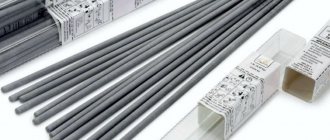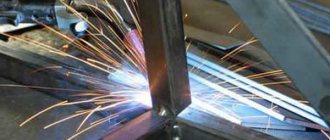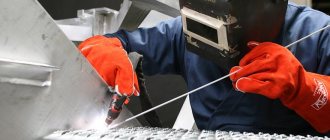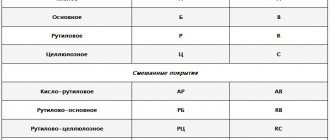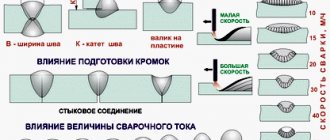Every person in life may have a situation when it is urgently necessary to solder a radiator, zinc bucket, enameled basin or other product. But not everyone has a welding machine or soldering iron at home or in the garage; to work with them you need to have certain skills. Therefore, an easy-to-use welding pencil can be an alternative for home craftsmen. It is used for thermal welding, surfacing and cutting of alloys and metals both in domestic conditions and during emergency rescue operations.
Operating principle
The pencil consists of a compressed mixture of aluminum and iron oxide. When such a material ignites, a large amount of heat is released (exothermic reaction). From a chemical point of view, there is a reduction reaction of Fe from the oxide with the participation of Al. When molecular bonds in the oxide are broken, a release of thermal energy is generated.
The temperature of the reagents rises to such an extent that the reduced iron immediately passes into the liquid phase state, or simply melts. This molten metal penetrates and fills holes, crevices and cracks in the parts being joined or repaired.
Oxygen atoms released from the oxide molecules react with aluminum to form aluminum oxide. It plays the role of a flux, preventing re-oxidation of the melt and areas of the product heated to the plasticity temperature.
The welding pencil contains all the necessary components for welding:
- filler metal to form the weld material;
- flux that protects the weld pool from oxygen and nitrogen in the air;
- source of thermal energy for melting metal.
The chemical composition of pencils may vary. Instead of aluminum, magnesium can be used as a reducing agent. The reducing metal is selected depending on what alloys the specific pencil model is intended for welding.
In pencils intended for welding work on thick parts, a metal rod is inserted in the middle - its metal will be used to form the suture material.
Safety precautions
When working with a pencil, you must strictly follow safety precautions to avoid getting burns on your body.
- Do not work near flammable liquids or materials.
- The place where welding work is carried out must be provided with fire extinguishing equipment.
- Before welding, you must wear thick gloves, safety glasses or a welding helmet, as well as special clothing.
- Keep the lit thermal solder at a distance from you using pliers or other devices.
- If it is necessary to seal a container after fuels and lubricants, it must be thoroughly rinsed and dried before welding.
- Do not work near electrical wiring that is not de-energized.
- Since the combustion of a dry combustible substance inside a pencil produces smoke, it is not advisable to inhale its vapors.
- When welding fistulas and cracks in batteries and pipes, you must first drain the water.
- After welding work, you need to check that there is no smoldering or fire around.
Varieties
Manufacturers throw many brands and models of welding sticks into the market. Not all of them are made with sufficient quality; for some, even the chemical composition remains unclear.
Extrapike
It is better not to experiment and stick to products from manufacturers that have proven themselves over many years:
- Thermal pencil for Extrapike welding. Suitable for repairing and welding deep cracks and through holes in steel, aluminum, alloys, and enameled products. Carries out tinning of surfaces, restoration of the enamel layer. The shelf life is practically unlimited, the consumption during operation is quite high.
- Universal pencil Nanopayk. Manufactured using magnesium as a reducing agent. Can work with any metals and alloys. Noticeably more expensive.
- Extreme. With its help, you can repair metal parts, both with and without enamel coating. Affordable. The manufacturer claims that the strength of the weld reaches 70% of that of a weld made by electric welding.
Welding pencil Extreme
There are other brands of pencils on the market that are similar in quality and capabilities.
Popular pencil manufacturers
The most popular welding rods are the following brands:
- “New Formula” Thermal soldering pencil, which is sold in many construction and hardware stores. Allows you to carry out repairs at any time of the year, in a wide temperature range. It’s easy to work with; all you need to do is read the instructions carefully.
- "Weld Force". This brand produces various pencils that form a strong and reliable weld. The products differ in the basis of the soldering and welding mixture.
- "Extreme Extramoment". Ideal for quick repairs of tanks, pipes, radiators, it allows you to solve the problem in 5 minutes.
Soldering and welding rod EKhZ 1152
Technology of use
The process of using a welding pencil is quite simple and can be done by any home craftsman. The sequence of operations is as follows:
- Prepare the surface thoroughly by cleaning it with a wire brush or abrasive paper to remove rust, old paint residue and other contaminants.
- Degrease with gasoline, white spirit or other solvent.
- Remove the packaging from the pencil. Move the metal cover to the other end of the rod - we will hold it by it.
- Don’t forget to wear welder’s goggles (or mask) and thick canvas (split) gloves.
- Use a match or lighter to heat and set the end of the rod on fire.
- Bring the burning end to the starting point of the weld and press it to the surface of the part. Guide the rod along the seam line, holding in one place for at least 3 seconds, so that the welded edges have time to warm up to the melting temperature.
- Welding is carried out without hesitation, if with the right hand, then from right to left. If the welding speed is too high, the welding gap will fill with slag, but not enough melt will get into it to make a reliable connection.
At the end of the welding work, the stub of the rod must be placed on concrete, the ground (without dry grass) and thrown into a bucket of water.
Welding pencils. Where can I buy?
Welding pencil "Lebedeva" - development and production of autonomous tools for welding, cutting, metal processing: soldering and welding pencils ELKAS, cutting pencils ELKAS-TERMIT, checkers, pastes and other "non-energy" tools and means according to the patents of a professor, Doctor of Technical Sciences Lebedev Vladimir Georgievich. The basic model produced by the ELKAS pencil provides welding and brazing of all types of steel and cast iron (iron-carbon alloys) with a thickness of 0.3 to 6 mm.
The price in Hohland is only 0.29 USD – 2.27 USD depending on the amount of termite
Technical characteristics Non-volatile exothermic cutting pencil ELKAS-TERMIT Shelf life at temperatures from +5 to 25 C and relative humidity 60% - 2 years. Ignition temperature - 800 C Burning temperature - 3000 C Burning time of a pencil 200 mm long - 25 +(-) 4 s Depending on the diameter and length, it can cut steel rods with a diameter of up to 22-25 mm and sheet material with a thickness of up to 6-8 mm. The instructions in which each pencil is wrapped contain a table corresponding to the diameter of the pencil and the thickness of the metal sheets or rods being cut. In thicker sheet material, for example 10 mm or more, using one or more pencils, you can cut a hole large enough to provide emergency assistance (for example, supply a hose with air). Pencils are available in diameters of 12, 14, 16 mm and lengths of 150, 200, 250 mm.
Does anyone know if THIS can be bought somewhere?
Zillo
Zillo
The main thing is to press it tighter. The disadvantages are light and a lot of smoke, short seam length.
"OXAL" - DOUBLE AGENT ZR.RU Behind the wheel No. 2 1999 The article was read 104 times page 1
The talk about the sale of rulers and hooks in stores that unlock cars without keys had not yet subsided, and liquid nitrogen had not yet evaporated from the keyholes, when rumors reached us about a certain “magic wand” capable of both welding and cutting metal.
Is it possible: to get a welded joint, you only need a box of matches, a canvas glove, glasses and a small pencil that resembles a column of compressed metal shavings? Now all that remains is to light the wick.. It is precisely for what purposes the match will be brought to the wick that determines whether the power of the pencil will be harmful or beneficial. Let's start, as appropriate, with what is beneficial. So, the role of the welding machine (it was called “Oxalom”) is played here by the handle and the cardboard shell of the pencil, and its contents - a mixture of flux powders, filler material and thermite mixture - serve as the working fluid. On what principle does a pencil work? The thermite charge, mixed with the named components, burns, melts them and transfers them to the welding zone. Flux protects the weld pool from environmental influences, and additives replenish burnt-out alloying elements. The temperature range that allows the use of welding pencils is very wide: from -100 to +100° C. Weather conditions, as well as magnetic and electric fields, are not an obstacle to the process: after all, there is no contact with a high voltage network. Still, the safety precautions taken during normal welding work will not hurt. And remember: to avoid steam burns, it is strictly forbidden to extinguish pencils with water!
FROM EACH ACCORDING TO ABILITY “Oxal-1”. The capabilities of the smallest Oksal are limited to welding low-alloy steels with a thickness of 0.5 to 1.5 mm. Based on this, we felt that the little one was quite capable of welding the fallen-off bracket for the VAZ 2102 gas tank flap (of course, not on a car). We didn’t find any special requirements for preparing the surfaces to be welded in the instructions, so we wiped the parts with a rag and got down to business. Having flared up like a sparkler, the pencil began to rapidly melt. According to the instructions, its “lifetime” is only 20 seconds. Let's cook! And here are the first difficulties. The burning end of the pencil should be kept 3-5 mm from the weld. It turned out to be not so easy to comply with this seemingly simple requirement. The speed of the process and the bright sheaf of flame do not allow you to accurately estimate the distance, and there is a danger of overheating or burning parts. As a result, the seam turned out to be uneven (a lot of metal was splattered around the periphery), and the part was severely distorted. Conclusion: It is not advisable to use a welding pencil for welding thin sheets of metal. If it still suits you, then practice before you get down to business. "Oxal-2". It promises to weld steel parts with a thickness of 1.5-3 mm, as well as ensure reliable contact of copper wires with a diameter of up to 13 mm. It seems that you cannot find a better welder for garage and country work. Let's see how he copes with corner No. 30. Although he has a little experience behind him, he still has some experience. Press the corners together. Ignition! The parts are quite massive, so we try to warm them up thoroughly. We draw the “flame” along the seam, trying to maintain the distance to the surface specified in the instructions. The work is done. The remains of the pencil burn out on the asphalt. Under the slag crust we find an unsightly but strong seam, although the parts are clearly overheated (the metal has leaked in places). By hitting the corners on the asphalt, we check the connection for strength - it holds up! Conclusion: in the garage, on a long journey, or at the dacha, having an Oxal-2 welding pencil in the tool kit will not be superfluous.
MAHMUD, BURN IT! "Oksal-M" is the largest and most powerful welding pencil in the "Oksal" family. Give him some hot work. According to the manufacturer, he is quite capable of welding cast iron parts with a thickness of 3 to 7 mm with preheating with a blowtorch, as well as joining steel sheets with a thickness of 3 mm without preheating. They didn't check. We were interested in something else, and we asked a question that probably already made some of the owners of mechanical anti-theft devices shudder - would they use a pencil as a cutter? Well, let's try to burn out the steel rod of the pedal-steering wheel lock. So, who wins? 2800°C and about 20 seconds against a 13mm steel rod protecting the car, and no rules. One second, two, five. Under the pressure of the fiery stream, the steel rod became red-hot, but did not yield a single millimeter to the enemy. Six - the metal, crimson from the temperature, still resists the attack of the flame. Seven eight. A silvery stream of molten iron announces the victory of fire. At the eighteenth second, the constipation gave way. However, hope, as we know, is the last to die. Moreover, we did not “work” inside the car and the anti-theft device that died in an unequal battle was a domestic product. But cars are often protected by titled imported products. Shall we take a risk? This time, the springboard for the experiment is the G8, the weapon of the crime is the same Oksal-M, and the Fort Knox is a very expensive mechanical anti-theft device from very eminent parents (we deliberately do not list the brand). Since it was necessary not only to neutralize the “guard”, but not to cause harm to the car, additional equipment was made - a steel protective screen. Action plan: we get into the car interior, insulate the surfaces mating with the anti-theft with fireproof material (along with the screen we used an asbestos fire blanket), cut the bracket that secures the gearbox shift lever. . The fuse flared up as usual - let's go! We direct the fiery stream to the center of the steel arch, time has passed. One, two, three - the “foreigner” with dignity holds back the onslaught of fire. Six, eight, ten, eleven - most of the pencil was burned. Will the guard really survive? Twelve, fifteen - and the enemy’s defense is broken. Another five seconds and the lever is free. The pencil gave all of itself to the fight - it burned without a trace. But what is it? The interior smelled of burnt plastic! We instantly throw off the protective blankets and begin to extinguish the decorative panel: the multilayer steel-asbestos protection could not stand it - and through the opened gap, fire and molten metal reached the floor upholstery. Conclusion: an attacker should hardly try to use Oxal in the inside of a car - it is very dangerous. In addition, his equipment should include a fire extinguisher and an asbestos blanket, which will certainly attract the attention of others. Oksal welding pencils are already offered in stores. We hope they all fall into good hands. On a long journey, in the field, at the dacha, in the garage, “Oksal” will allow you to solve local “welding” problems without high costs, especially as an ambulance. By the way, in December in Moscow you could buy a pencil for 30 to 50 rubles, depending on the modification.
source
Advantages and disadvantages of using thermite pencil
The main advantages of a metal welding pencil include:
- Ability to work in the most cramped, hard-to-reach places.
- Energy independence - no sources of electricity or gas are required.
- Small size - fits into a workwear pocket.
- The work does not require long training or special skills.
- Can work both in a workshop and in the field.
- The heat resistance of the seam is up to 180 °C, which makes the device indispensable when repairing household utensils and dishes.
- Cheapness.
Using a Welding Pencil
In addition to the advantages, like any actually used welding method, there are also disadvantages:
- The quality of the seam is lower than with electric or gas welding.
- Not suitable for large volumes of work.
- High material consumption.
The combination of advantages and disadvantages makes the method ideal for minor operational repairs.
Is it possible to make an extrapike yourself?
The composition and design of a thermite pencil are not that complicated. Essentially, extrapike is a compressed mixture of aluminum and iron oxide in the shape of a stick.
What we need:
1. Aluminum sawdust.
2. Iron oxide, iron scale.
3. Cylindrical shape and stick.
4. Sparkler.
You can find out where to find these ingredients within the house on the Internet, we tell you how to make a thermite rod from them.
How to make your own thermite rod.
1. In a ratio of one to three, mix aluminum filings and iron oxide, respectively. This must be done in clay or glass containers.
2. Then, as shown in the photo, we begin to compact the composition tightly into the mold.
We do not fill the cylinder completely; we must leave room for the handle.
3. Next, we take out the resulting checker, attach a handle to it and stick a sparkler. The sparkler will serve as the ignition for our device.
In fact, you can do without a mold, the main thing is to compact the mixture well around the sparkler.
Our thermite rod is ready to go. It will be a little weaker in power than the purchased one, but it still copes with its tasks well. Such a thermite block can cut metal, weld it, and make through holes. The photographs below show the results of working with such a homemade extra solder.
What metals can it work with?
Due to their versatility, welding pencils can be used for welding materials such as:
- structural steel alloys;
- galvanized sheet metal;
- cast iron;
- aluminum alloys;
- copper alloys: bronze, brass, etc. ;
- stainless and high-alloy alloys;
- heat-resistant plastics.
Minor repairs with a thermal pencil
Industrial pencils of a special composition are also used for welding other metals, as well as for welding work under water, in a vacuum and other extreme conditions.
What is a welding pencil
When repairing metal products, it is very difficult, almost impossible, to do without welding.
In situations where there is no welding machine nearby, and the problem is acute, you can use an extra solder welding pencil. The invention is based on the known reaction of the thermite mixture. For this reason, the pencil is sometimes called thermite. The successful introduction of chemical transformation into practice allows many metal parts to be repaired in the field.
Preparing for work
Careful preparation of the workplace and parts to be welded will be the key to high quality and safe welding work.
The workplace must be cleared of flammable materials, fuels and lubricants and other flammable liquids. The parts to be welded must be mechanically cleaned of dirt and degreased.
The parts to be welded must be pressed against each other and securely fixed in a vice, clamps, or other inventory fastening devices.
Advantages of working with a welding pencil
Welding rods have the following advantages:
- To carry out welding work, you only need an open flame, unlike a welding machine, which requires electricity.
- It does not take up much space and is resistant to temperature changes, so it is a frequent companion on hikes.
- You can carry out repairs anywhere: from your own apartment to completely field conditions.
- The repair does not take much time and after a couple of minutes the product can be used again, moreover, the connection is sealed and relatively durable.
- Affordable price (on average from 50 to 200 rubles per package).
DIY making
Pencils are freely sold in general construction and specialized welding stores. In addition, they can be made independently.
To begin with, you will need carbon steel alloy wire. The electrode rod is excellent for manual electric welding. The flux coating needs to be removed from it.
Electrodes for manual welding
The composition for its own coating contains:
- one part of aluminum sawdust;
- three parts iron oxide;
- The binder is moment glue or other strong glue.
The preparation of the composition is carried out in a strong and stable container made of glass or clay. The electrode rod (or pieces of wire cut into 15 cm pieces) is dipped into the mixture and layers of the composition are wound onto it by rotating around the axis of the rod.
One end is left clean - it will act as a handle. The other will have the lighter mixture applied to it. It is prepared in a separate container in the following proportion:
- 1 part bertholet salt;
- 2 parts aluminum crushed to sawdust.
After thorough mixing and adding the same glue until a thick viscous mass is formed, small balls are rolled out of it, which are placed on the end of the pencil intended for ignition. Drying time - up to half an hour (or as indicated in the instructions for the glue).
Our welding pencil is ready, we can begin testing and welding training.
Description of the device
A welding stick, or thermal solder, is a thin-walled tube or rod of flammable material. On one side the tube is filled with a dry flammable substance, and on the other it is closed with a plug. The substance is an exothermic mixture that consists of flux and solder.
The diameter of the product can be from 4 to 16 mm , and the length of the tube can be from 7 to 20 mm. Pencil device:
- incendiary mixture;
- exothermic process mixture;
- cardboard sleeve;
- hole for pen holder;
- shell from instruction label;
- outer protective waterproof shell.
The average burning time of the rod is at least 30 seconds, the maximum combustion temperature is from 2200 to 2900 degrees Celsius, the weight is no more than 80 g. Depending on the thickness and type of material, the length of the seam can be from 8 to 15 cm.
Areas of application
The scope of application of welding pencils is the widest. They allow you to weld ferrous and non-ferrous metals in any position and in almost any circumstances, from workshop conditions to field and extreme conditions. The product is widely used in the following areas:
- Installation and emergency work in hard-to-reach places and in emergency situations.
- Prompt repair of vehicles (automobile, water, railway) in places where they break down.
- Repair of rail tracks, switches and crossings.
- Soldering copper wires and other electrical components.
- Repair of cracks in heating system components.
- Elimination of leaks in main and distribution pipelines.
- Repair of cast iron and bronze castings for industrial and decorative purposes.
- Repair of construction and agricultural equipment at remote sites.
Soldering pencil instantly
Welding pencils are especially widely used in rail repairs. Their use makes it possible to carry out routine repairs extremely quickly, inexpensively and with minimal delays in train movement.
It is important to remember that the pencil is intended for quick, temporary repairs at a great distance from repair facilities or in emergency circumstances. For continuous operation, high-quality repairs should be carried out using electric or gas welding.
Where is the product used?
The welding pencil can be used to connect vertical, inclined and horizontal seams. It can be used for the following purposes: Repair and installation work in extreme conditions. Prompt correction of breakdowns in cars, water and railway transport. Welding copper wires. Repair of heating systems and pipelines. Repairing cracks and chips in bronze and cast iron. Corrections for deficiencies in agricultural machinery. Cutting metal in difficult conditions.
Rules for safe use
Despite the extreme simplicity of their design and use, welding pencils pose a real threat to health, human life and the safety of material assets. To avoid tragic consequences, safety precautions should be strictly observed:
- Carefully prepare the workplace, remove all combustible and flammable substances and materials.
- Securely secure the workpiece or the product being repaired in a vice, clamps, clamp, etc. Cooking by weight is strictly unacceptable.
- Use only non-combustible materials for seam pads and welding shelves.
- It is mandatory to use personal protective equipment: goggles or a welder’s mask, canvas mittens or split-leaf gloves - leggings, thick clothing and durable shoes that do not leave exposed skin.
- When igniting and welding, you should hold the pencil firmly. Move it along the seam line smoothly, without jerking. It is unacceptable to walk around the workshop with a burning pencil.
- When welding on vertical and inclined surfaces, as well as when cutting metal, carefully ensure that the molten metal does not flow towards you or splash around.
- At the end of welding, the cinder should be thrown into a previously prepared bucket of water or sand. As a last resort - on a concrete or earthen floor. Do not leave the workplace without making sure that the cinder has burned completely.
Proper use of an inexpensive and easy-to-use cooking agent will make working with it convenient and safe.
How it all began…
Germany in the 30s of the twentieth century was a leader in the field of thermite welding technologies.
The technology received its rapid development primarily in crucible welding - now connecting two parts of a railway rail is not difficult.
In short, the welding fixture consists of:
- Crucible;
- Thermite mixture;
- Rails;
- Split fireproof mold
Intermediate casting method (before, during and after casting)
Heating the metal
The most commonly used means of heating the surface is a gas burner.
It can run on propane or butane. But at home, a regular gas blowtorch is quite suitable.
When heating, you should control your actions so that the elements being connected do not begin to melt. To do this, the surfaces are often touched with solder in order to promptly notice its melting, confirming that the desired temperature has been reached. When heating parts, the burner flame must be monitored. It should be well-balanced, bright blue in color, and small in size.
TEC Torch Promotion
Tech Torch - a laser sword from "Star Wars" - as it was dubbed in the USA
There is also a foreign analogue (startup in the USA) TEC Torch Promotion - a thermite cutting device with a replaceable cartridge (the device costs $300; the cartridge costs $50).
In America, TEC Torch is used as a compact tool that can be used by American law enforcement agencies, military personnel, and emergency services in their work. TEC Torch can open any door in a matter of seconds, which can save the lives of people caught in force majeure circumstances.
Thermite cutter in action
The combustion time of the cartridge is only a few seconds - the optimal time for surgical intervention. The Rod Cutter cartridge can burn through a rod up to 2cm in diameter (whether it's hardened, mild steel or stainless steel), and the Plate Penetrator cartridge can cut a hole up to 1cm in a metal plate up to 1.3cm thick. Complex tasks may require multiple cartridges or a combination of cartridges.


